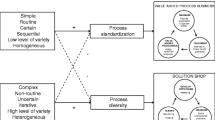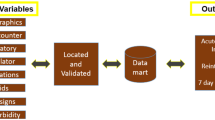Abstract
Standardized clinical pathways are useful tool to reduce variation in clinical management and may improve quality of care. However the evidence supporting a specific clinical pathway for a patient or patient population is often imperfect limiting adoption and efficacy of clinical pathway. Machine intelligence can potentially identify clinical variation and may provide useful insights to create and optimize clinical pathways. In this quality improvement project we analyzed the inpatient care of 1786 patients undergoing colorectal surgery from 2015 to 2016 across multiple Ohio hospitals in the Cleveland Clinic System. Data from four information subsystems was loaded in the Clinical Variation Management (CVM) application (Ayasdi, Inc., Menlo Park, CA). The CVM application uses machine intelligence and topological data analysis methods to identify groups of similar patients based on the treatment received. We defined “favorable performance” as groups with lower direct variable cost, lower length of stay, and lower 30-day readmissions. The software auto-generated 9 distinct groups of patients based on similarity analysis. Overall, favorable performance was seen with ketorolac use, lower intra-operative fluid use (< 2000 cc) and surgery for cancer. Multiple sub-groups were easily created and analyzed. Adherence reporting tools were easy to use enabling almost real time monitoring. Machine intelligence provided useful insights to create and monitor care pathways with several advantages over traditional analytic approaches including: (1) analysis across disparate data sets, (2) unsupervised discovery, (3) speed and auto-generation of clinical pathways, (4) ease of use by team members, and (5) adherence reporting.




Similar content being viewed by others
References
Institute of Medicine (US) Roundtable on Value & Science-Driven Health Care, Yong PL, Olsen LA, McGinnis JM, editors. Value in health care: accounting for cost, quality, safety, outcomes, and innovation. Washington (DC): National Academies Press (US). 2010. Institute of Medicine: Roundtable on Value & Science-Driven Health Care: Charter and Vision Statement. https://www.ncbi.nlm.nih.gov/books/NBK50934/.
Schrijvers G, van Hoorn A, Huiskes N. The care pathway: concepts and theories: an introduction. Int J Integr Care. 2012;12:e192. (Spec Ed Integrated Care Pathways).
Gustafsson UO, Scott MJ, Schwenk W, et al. Guidelines for perioperative care in elective colonic surgery: enhanced Recovery After Surgery (ERAS(R)) Society recommendations. Clin Nutr. 2012;31(6):783–800.
Cerantola Y, Valerio M, Persson B, et al. Guidelines for perioperative care after radical cystectomy for bladder cancer: Enhanced Recovery After Surgery (ERAS((R))) society recommendations. Clin Nutr. 2013;32(6):879–87.
Mould G, Bowers J, Ghattas M. The evolution of the pathway and its role in improving patient care. Qual Saf Health Care. 2010;19(5):e14.
Panella M, Marchisio S, Di Stanislao F. Reducing clinical variations with clinical pathways: do pathways work? Int J Qual Health Care. 2003;15(6):509–21.
Hinks TS, Zhou X, Staples KJ, et al. Innate and adaptive T cells in asthmatic patients: relationship to severity and disease mechanisms. J Allergy Clin Immunol. 2015;136(2):323–33.
Li L, Cheng WY, Glicksberg BS, et al. Identification of type 2 diabetes subgroups through topological analysis of patient similarity. Sci Transl Med. 2015;7(311):311ra174.
Nielson JL, Paquette J, Liu AW, et al. Topological data analysis for discovery in preclinical spinal cord injury and traumatic brain injury. Nat Commun. 2015;6:8581.
Carlsson G, Campion FX. Machine intelligence for healthcare, vol 1. Scotts Valley: CreateSpace Independent Publishing Platform; 2017.
AYASDI. TDA and machine learning. Better together. 2017. https://s3.amazonaws.com/cdn.ayasdi.com/wp-content/uploads/2017/08/28134706/WP-TDAandML-BetterTogether-07172017.pdf. Accessed 3 March 2018.
Breda A, Bui MH, Liao JC, Schulam PG. Association of bowel rest and ketorolac analgesia with short hospital stay after laparoscopic donor nephrectomy. Urology 2007;69(5):828–31.
Schlachta CM, Burpee SE, Fernandez C, Chan B, Mamazza J, Poulin EC. Optimizing recovery after laparoscopic colon surgery (ORAL-CS): effect of intravenous ketorolac on length of hospital stay. Surg Endosc. 2007;21(12):2212–9.
Khuri SF, Henderson WG, DePalma RG, et al. Determinants of long-term survival after major surgery and the adverse effect of postoperative complications. Ann Surg. 2005;242(3):326–41. (discussion 341–323).
Lilot M, Ehrenfeld JM, Lee C, Harrington B, Cannesson M, Rinehart J. Variability in practice and factors predictive of total crystalloid administration during abdominal surgery: retrospective two-centre analysis. Br J Anaesth. 2015;114(5):767–76.
Joynt KE, Jha AK. Thirty-day readmissions—truth and consequences. N Engl J Med. 2012;366(15):1366–9.
Mattar MC, Lough D, Pishvaian MJ, Charabaty A. Current management of inflammatory bowel disease and colorectal cancer. Gastrointest Cancer Res. 2011;4(2):53–61.
Author information
Authors and Affiliations
Contributions
KM, JC, RA, TC: helped design the study, analyze the data, revise the article for scientific and intellectual content, and prepare the manuscript. PM, FXC: helped analyze the data, revise the article for scientific and intellectual content, and prepare the manuscript. DL, KR, AK, KCC: helped revise the article for scientific and intellectual content, and prepare the manuscript.
Corresponding author
Ethics declarations
Conflict of interest
Francis X. Campion served as Chief Medical Officer for Ayasdi Inc during this project. None of the other authors have a personal financial interest in this work.
Rights and permissions
About this article
Cite this article
Maheshwari, K., Cywinski, J., Mathur, P. et al. Identify and monitor clinical variation using machine intelligence: a pilot in colorectal surgery. J Clin Monit Comput 33, 725–731 (2019). https://doi.org/10.1007/s10877-018-0200-x
Received:
Accepted:
Published:
Issue Date:
DOI: https://doi.org/10.1007/s10877-018-0200-x




